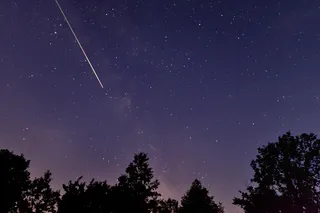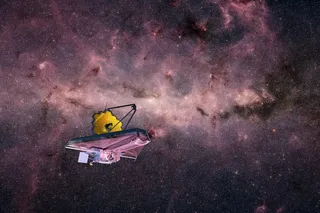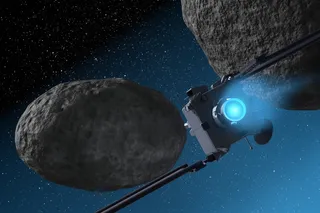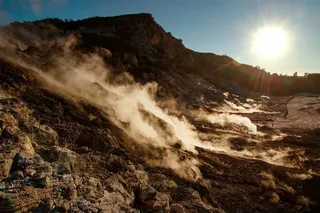The Romantic poet John Keats once defined a state of mind wherein a person "is capable of being in uncertainties, mysteries, doubts, without any irritable reaching after fact and reason." He called it negative capability. It stands in direct contrast to the quality known as negative pressure, a scientific conundrum that recently caused much irritable grasping after fact and reason among Discover readers.
The trouble started last September, when Discover published my Works in Progress column about how water gets to the tops of trees. As water evaporates from a tree's leaves, I reported, it tugs on water remaining in the xylem, a network of inert pipes that reaches from roots to shoots. Water molecules in the xylem, I innocently explained, are linked by bonds that form among their positively and negatively charged poles. As water evaporates up top, it stretches the bonds between interlinked molecules in the column below, generating considerable tension. "The pressure inside the xylem tubes of the tallest trees could be as low as -20 atmospheres," I wrote.
And the irritable grasping began. "Negative pressures of 20 atmospheres? Impossible," one reader wrote. "You can't make empty space more empty!" another protested. "Please tell me that the Works in Progress is a misplaced April Fools' Day article," yet another implored.
For what it's worth, the negative-pressure theory of water transport is enshrined in plant physiology textbooks. But plant physiologists do not have the last word in physics. So I called Princeton University physicist Paul Steinhardt, whom I'd interviewed a year before for an article about the accelerating universe. Steinhardt had gone to great lengths to explain the cosmological version of negative pressure to me. Einstein's equations allow for a ubiquitous, inward-pulling force in the universe that behaves like a rubber band, Steinhardt said. The more you stretch it, the more it pulls back. No one knows exactly what's doing the pulling, but the contracting force could exist in empty space because the vacuum is full of energy and other intangibles.
I asked Steinhardt if the same negative pressure that is tugging on the firmament could also be pulling water to the tops of trees. Not a chance, he said. Liquids can't have negative pressure.
I called plant physiologist Michele Holbrook at Harvard University, a source for the tree story, to give her the bad news. She wasn't buying it. Negative pressure is a legitimate component of fluid dynamics, she told me emphatically, if not irritably. Then she gave me a list of physicists who would vouch for it.
There ensued a messy interlude in which I consulted a sampling of knowledgeable experts, including my brother, Harold. Hal, a high school physics teacher, is wont to say that "the universe doesn't suck; it blows." He means that fluids flow along pressure gradients, from higher to lower pressures. Sucking on a straw, for example, creates a low-pressure area at the top of the straw, and the higher atmospheric pressure pushes the fluid up from the bottom.
Unfortunately, Hal's law falls short of explaining how water climbs trees. Experiments have shown that atmospheric pressure alone can only push water 33 feet up a vertical tube, and trees can grow much taller than that. Also, I had been told repeatedly that the water in xylem tubes is under tension—which sounded like pulling, not pushing, to me.
Finally, through a contact on Holbrook's list, I found Pablo Debenedetti, an expert in fluid thermodynamics at Princeton whose book, Metastable Liquids, includes a section on water transport in trees. In the parlance of fluid dynamics, Debenedetti told me, negative pressure is tension—the stress resulting from the elongation of an elastic body. Liquids really can stretch. Under certain conditions, if you pull on them, they pull back. "You can actually have the liquid 'suck' a vessel," Debenedetti said. "In laboratory experiments, you can make vessels implode."
All liquids can have tensile strength, he added, generated by the momentary accumulations of charge from quantum fluctuations in atoms. Tension in liquids has been studied since the mid-1800s. In the 1950s, the National Institute of Standards and Technology determined the tensile strength of a variety of liquids by suspending them in Z-shaped glass tubes with open ends. Each tube was put in a centrifuge and spun around until a bubble formed in the liquid; the liquid's tensile strength was calculated from the centrifugal force required to form the bubble.
Debenedetti confirmed that water's tensile strength is partly a result of attractions between opposite charges on the poles of water molecules. Still, he said, the concept of negative pressures in liquids isn't obvious. At equilibrium, water and other liquids don't support tension. It's only a property of metastable liquids—liquids prevented from entering a new phase by an energy barrier. Water can be kept liquid, for example, at temperatures more than 300 degrees Fahrenheit above its boiling point, because it needs a onetime injection of energy to start vaporizing. A liquid under tension wants to be vapor, but it needs a boost, or a lowering of its energy barrier, to change phases. Until that happens—when the liquid is shaken, for instance, or its tension is increased—the liquid stretches. Such is the case in the xylem tubes of trees.
Debenedetti and Steinhardt don't work in the same building at Princeton, but they know of each other because their daughters share the same piano teacher. At my request, the two exchanged a few e-mails and concluded that each man's negative pressure was a stranger to the other. I also approached cosmologist Michael Turner at the University of Chicago, who conferred with his friend Humphrey Maris, a physicist and fluid-dynamics expert at Brown University. After talking to Maris, Turner helped put the two realms together.
"We're not talking about the same phenomena," he said. The two kinds of negative pressure are related, though, "in the sense that they are examples of things that behave elastically. And both are a bit counterintuitive."
If there is a unifying theme here, Turner said, it's direction—an inward, imploding, or contracting force, rather than the outward-pushing force typically defined as pressure. The minus sign next to those atmospheres doesn't mean "less than nothing"; it's an arbitrary signifier denoting "in the direction opposite of positive." Solids have negative pressure when they pull in, like stretched rubber bands or springs. Liquids can have negative pressure in metastable states, when they resist turning to vapor. And, according to the astrophysicists, even empty space can have negative pressure.
Gases are still the dark horse in the meta-stable. Steinhardt has heard that metastable gases can have negative pressure, but he isn't sure how. Debenedetti is skeptical. "The whole point of being a gas is that the forces between molecules don't matter much," he says. Turner is noncommittal.
Since the many facets of negative pressure are obscure enough to escape career physicists, I figure readers can be forgiven their confusion. Negative pressure, it seems, is the perfect remedy for overstretched intellects.














